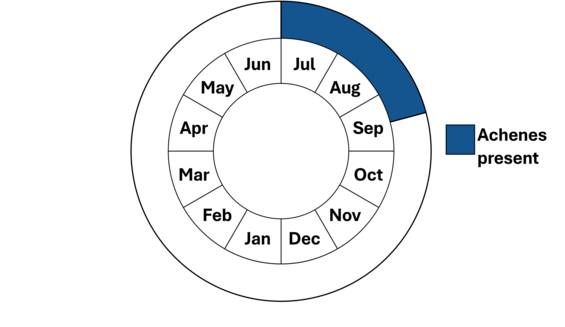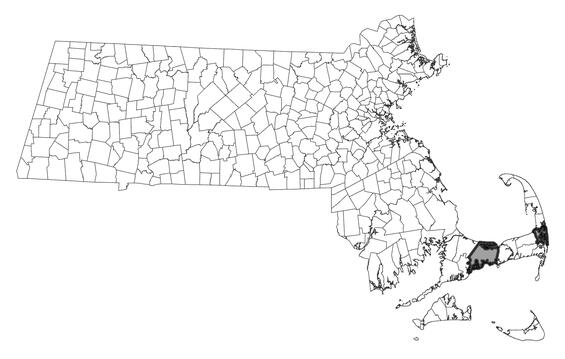- Scientific name: Eleocharis melanocarpa Torr.
- Species of Greatest Conservation Need (MA State Wildlife Action Plan)
Description
Fruiting heads. Photos by Douglas E. McGrady.
Black-fruited spikesedge (Eleocharis melanocarpa) is an herbaceous perennial species in the sedge family (Cyperaceae). Spikesedges have bladeless stems with terminal spikelets found in wetland areas. Black-fruited spikesedge are tufted plants, growing each year from a persistent base. Its stems are wiry and flattened, 10-70 cm (4 -25 in) in height, some of which will arch over to the substrate and root at their tips. The terminal spikelets are elliptical to cylindrical, 0.6 -1.4 cm (¼-½ in) long. The scales in the inflorescence are rounded with a scarious upper edge, reddish-brown in color, each closely appressed, 3-4 mm (0.12-0.16 in). The trigonous achene is smooth, black, and shining, has concave sides, and 1-1.4 mm (0.04-0.06 in) long. Each achene is tipped with a sessile (has no stem), pale tubercle, that is the same width as the achene with a pointed tip.
Achenes
Plant
Life cycle and behavior

Black-fruited spikesedge is the only freshwater species of spikesedge that arches over and takes root forming dense mats along the shores of coastal plain ponds in Massachusetts. Often the whole plant lays prostrate by late summer. As a member of the sedge family, it is wind-pollinated. Achenes are present from beginning of July through mid-September and fall off and disappear quickly once mature.
Population status
Black-fruited spikesedge has recently been added to the list of species of greatest conservation need (SGCN) and is maintained on the plant watch list. There are currently 3 occurrences in the state verified since 1999 found in Barnstable County. Thirty-nine ponds have had populations of black-fruited spikesedge prior to 1999, though some of those have not been observed since the early 1900s.

Distribution in Massachusetts
1999-2024
Based on records in the Natural Heritage Database
Distribution and abundance
Massachusetts represents the northeastern extent of black-fruited spikesedge. From Massachusetts, it is known south along the coast to Florida and then west to Texas. There are disjunct populations in Indiana and Michigan. In almost every state where the species occurs it is of conservation concern. In New England, it is listed as critically imperiled in Massachusetts and Rhode Island; and is not known from any of the other states.
Habitat
Black-fruited spikesedge occurs on sunny, wet, peaty, sandy shores of coastal plain ponds. Associated species may include Plymouth gentian (Sabatia kennedyana – Special Concern), spatulate-leaved sundew (Drosera intermedia), rose coreopsis (Coreopsis rosea), bog yellow-eyed grass (Xyris difformis), three-way sedge (Dulichium arundinaceum), seven-angled pipewort (Eriocaulon aquaticum), many-flowered marsh-pennywort (Hydrocotyle umbellata), coastal grass-leaved goldenrod (Euthamia caroliniana), St. John’s-worts (Hypericum spp.) and various grasses.
Healthy habitats are vital for supporting native wildlife and plants. Explore habitats and learn about conservation and restoration in Massachusetts.
Threats
The primary threats to black-fruited spikesedge include trampling and raking beaches by people enjoying the pond but unaware of the presence of this species. Invasive plants, such as common reed (Phragmites australis) and gray willow (Salix cinerea), could shade this species that requires sunny, damp sandy locations to grow. Climate change is a major threat to all coastal plain pond species; as the sea levels rise, inland freshwater ponds’ water levels are pushed higher in elevation too. Climate change also brings more erratic rainfall, with more years of higher water levels flooding the populations, as well as longer periods of drought which this species may not be able to survive. (Staudinger et al. 2024).
Conservation
Survey and monitoring
Survey and monitoring black-fruited spikesedge is a high priority, starting with populations where it was most recently observed, obtaining information on the approximate population size and health, and then surveying for black-fruited spikesedge at sites where the species was observed historically. Best time to survey is in July and August.
Management
Invasive species such as common reed (Phragmites australis) and gray willow (Salix cinerea) may need to be control on the coastal plain pondshores where black-fruited spikesedge grows. All active management of rare plant populations (including invasive species removal) is subject to review under the Massachusetts Endangered Species Act and should be planned in close consultation with MassWildlife’s Natural Heritage & Endangered Species Program.
Research needs
As black-fruited spikesedge is under-surveyed, more standard information is needed such as lists of associated species, comments on habitat quality and threats, and assessments of soil conditions and phenology. Research is needed to determine whether this plant can be grown in a nursery or garden setting for purposes of reintroductions. If habitat degradation accelerates losses of current populations, this strategy could prove useful to long-term conservation of this species.
References
Arsenault, Matt, Glen H. Mittelhauser, Don Cameron, Alison C. Dibble, Arthur Haines, Sally C. Rooney, and Jill E. Weber. 2013. Sedges of Maine, A Field Guild to Cyperaceae. University of Maine Press, Orono, Maine.
Fernald, M. L. 1950. Gray’s Manual of Botany, Eighth (Centennial) Edition—Illustrated. American Book Company, New York.
Haines, A. 2011. Flora Novae Angliae – a Manual for the Identification of Native and Naturalized Higher Vascular Plants of New England. New England Wildflower Society, Yale Univ. Press, New Haven, CT.
Native Plant Trust. 2014. NORM Phenology Information.
NatureServe. 2025. NatureServe Network Biodiversity Location Data accessed through NatureServe Explorer [web application]. NatureServe, Arlington, Virginia. Available https://explorer.natureserve.org/. Accessed: 3/28/2025.
POWO (2025). Plants of the World Online. Facilitated by the Royal Botanic Gardens, Kew. Published on the Internet; https://powo.science.kew.org/ Accessed: 3/28/2025.
Seymour, Frank C. 1969. The Flora of New England, First edition. Charles E. Tuttle Company, Inc. Tokyo, Japan.
Staudinger, M.D., A.V. Karmalkar, K. Terwilliger, K. Burgio, A. Lubeck, H. Higgins, T. Rice, T.L. Morelli, A. D'Amato. 2024. A regional synthesis of climate data to inform the 2025 State Wildlife Action Plans in the Northeast U.S. DOI Northeast Climate Adaptation Science Center Cooperator Report. 406 p. https://doi.org/10.21429/t352-9q86
Contact
| Date published: | April 14, 2025 |
|---|